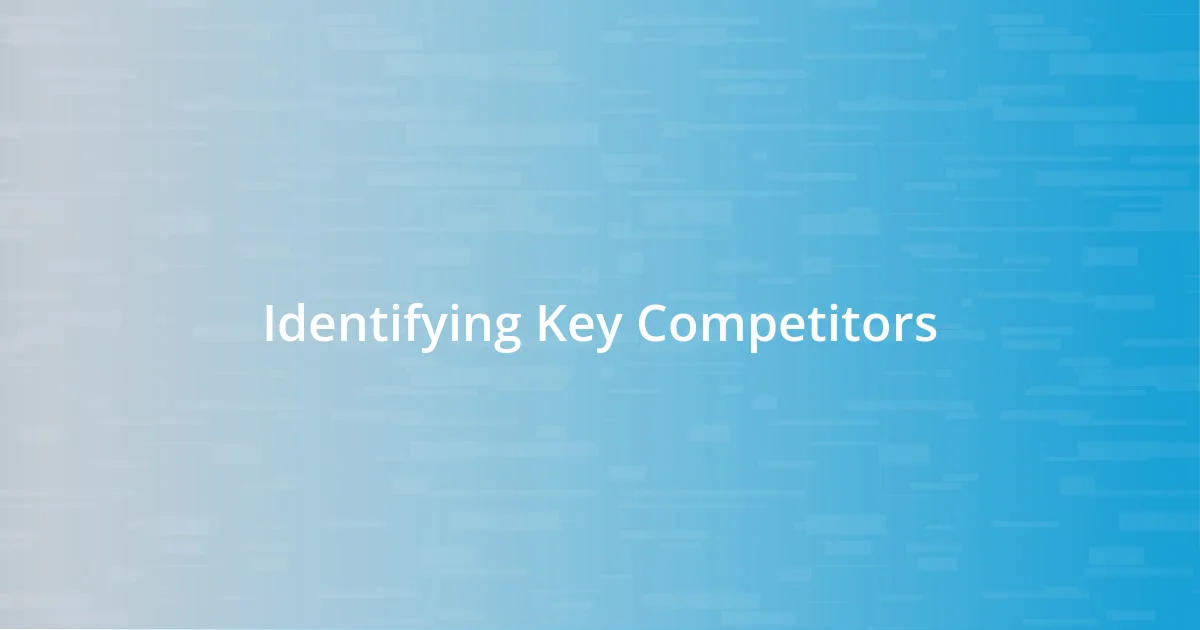Key takeaways:
- Competitive analysis reveals strengths, weaknesses, and market trends, allowing businesses to identify opportunities for improvement and innovation.
- Setting clear goals and collecting relevant data streamlines the analysis process, making findings actionable and focused on strategic objectives.
- Applying lessons from competitor analysis through adaptability and audience alignment leads to effective marketing strategies and ongoing business growth.

Understanding Competitive Analysis
Competitive analysis is like a treasure hunt for insights hidden in plain sight. I remember the first time I conducted one; I was nervous, but the findings gave me a clearer sense of my own strengths and weaknesses. Have you ever felt overlooked in your market? Understanding your competition helps you see where you stand and where you can improve, making it an essential part of any business strategy.
When I dive into competitive analysis, I think of it as peering through a window into my competitors’ worlds. Each competitor has strategies, audiences, and tactics that can provide valuable lessons. I’ve often found that the best ideas emerge not just from seeing what others do well, but also from recognizing their missteps. Isn’t it fascinating how much we can learn from both success and failure?
I used to shy away from analyzing my competitors, thinking it was an admission of inadequacy. However, I learned that understanding their movements can pinpoint market trends and consumer preferences. By embracing this perspective, I transformed my approach and often found opportunities I hadn’t considered before. Have you ever considered how your competitors’ choices could, directly or indirectly, shape your path forward?

Setting Clear Goals for Analysis
Setting clear goals for your competitive analysis is crucial. I’ve found that having specific objectives not only streamlines the process but also makes the findings more actionable. For instance, when I focused on understanding customer sentiment towards a competitor’s product, the insights guided my own development efforts. Without a clear goal, all the data can become overwhelming, making it easy to lose sight of what truly matters.
When establishing your goals, consider these key points:
- Identify what you want to learn: Are you looking to improve your product, refine your marketing approach, or track industry trends?
- Define success metrics: How will you know if the analysis has been useful? This could be increased engagement, higher conversion rates, or even just a clearer roadmap.
- Keep it flexible: The market changes, and so should your goals. Regularly review and adjust them based on new insights and emerging challenges.
In my early attempts, I would jump into the analysis without clear goals, often leading to frustration. However, once I pivoted to a more focused approach, it significantly enhanced my strategic decision-making process. Establishing clear goals felt like shining a flashlight into the darkness, illuminating the path forward.

Identifying Key Competitors
Identifying key competitors is a foundational step in competitive analysis that shapes the entire process. Reflecting on my experiences, I remember the first time I sat down to map out who my competitors were. It wasn’t just about finding businesses that offered similar products; it involved delving deeper into their market positioning, strengths, and weaknesses. This clarity can dramatically influence the strategies you adopt. When you recognize these players, you set the stage for strategic decision-making.
I learned that identifying competitors isn’t always straightforward, especially in a complex market. There are direct competitors—those offering the same products—and then there are indirect competitors who fulfill the same customer needs in different ways. For instance, in the fitness industry, a gym might see other gyms as their competitors, but they often overlook apps that promote home workouts. This dual lens can expand your perspective on potential threats and opportunities. Have you ever underestimated a competitor simply because they didn’t look like you on the surface?
Creating a comparison table offers a tangible way to visualize your competitive landscape. It’s astonishing how such a simple tool can spotlight gaps in your strategy and open your eyes to new possibilities. I remember compiling my first table and realizing that I had been so focused on a few key players that I completely missed emerging brands that were innovating in ways I hadn’t considered. This realization spurred me to rethink my approach to market positioning and customer engagement.
| Competitor | Strengths |
|---|---|
| Company A | Strong online presence, diverse product range |
| Company B | Exceptional customer service, loyal customer base |
| Company C | Innovative solutions, competitive pricing |

Collecting Relevant Data
Collecting relevant data is a crucial aspect of competitive analysis that can often feel overwhelming. Early in my research, I found myself drowning in vast amounts of information, unsure of what truly mattered. It wasn’t until I learned to focus on specific sources—like customer reviews, social media feedback, and industry reports—that the noise filtered into actionable insights. Have you ever experienced that moment when the right pieces of information click together, revealing a bigger picture?
To ensure I was gathering the most pertinent data, I developed a checklist tailored to my objectives. This included tracking competitor pricing, promotional tactics, and user experience. Each time I completed a round of research, I felt a sense of accomplishment, as if I was piecing together a puzzle that finally made sense. One particularly enlightening instance was when I discovered a competitor’s secret sauce for engaging their customers effectively, which led me to experiment with similar strategies in my own campaigns.
I’ve also found that leveraging tools like web scraping and customer analytics platforms can dramatically optimize data collection. For example, using web scraping tools helped me gather real-time pricing trends across various competitors without the tedious manual effort. After implementing this approach, I noticed an improvement in my responsiveness to market shifts. It’s fascinating how the right data can be the difference between guessing and making informed decisions. How do you currently collect data, and do you feel it truly serves your strategic needs?

Analyzing Strengths and Weaknesses
When I first started analyzing strengths and weaknesses, I was surprised by how many hidden facets could emerge. I remember one competitor that appeared to have it all figured out – strong branding, a loyal customer base, and impressive sales figures. However, digging deeper revealed gaps in their product range that my own offerings could fill. This taught me that even the most established players can have vulnerabilities just waiting to be exploited. Have you ever looked at a competitor and thought they were invincible, only to uncover cracks in their facade?
Reflecting on my experiences with SWOT analysis—strengths, weaknesses, opportunities, and threats—it became clear that understanding a company’s internal and external factors is crucial. Each time I conducted a SWOT analysis, I would jot down insights in a notebook, watching familiar themes emerge. One time, I noted that a competitor’s exceptional customer service was a significant strength, but their slow response times online highlighted a weakness. This dual perspective not only helped refine my competitive strategies but also sparked ideas for improving my own operations.
I also learned the importance of being honest in this analysis process. It’s tempting to focus solely on the bright side of your own business, but acknowledging weaknesses takes courage. I remember a moment when I had to confront the fact that my product didn’t quite stand up to a competitor’s in terms of features. Instead of feeling defeated, this realization ignited a drive within me to innovate and enhance my offerings. Isn’t it interesting how recognizing where we fall short can be the first step towards growth and improvement?

Extracting Actionable Insights
Extracting actionable insights is where the true magic happens in competitive analysis. I remember sifting through endless reports, feeling like I was searching for a needle in a haystack. But then it hit me—focusing on trends rather than isolated data points quickly transformed my approach. I started to look for recurring themes, such as how competitors responded to market changes or the types of content that garnered the most engagement. Have you ever had an epiphany that changed your whole perspective? Once I realized this, the insights became not just clear, but also intensely actionable.
There was a specific instance where I discovered a competitor’s strategy centered on user-generated content. I saw how it not only fostered community but drove engagement, too. Inspired, I adopted a similar approach, inviting my audience to share their experiences with my products. The result? A surge in genuine conversations and a strengthened connection with my audience. It’s incredible how such insights can lead to immediate and measurable impacts. How often do we overlook what’s right in front of us?
Ultimately, the real triumph lies in taking those insights and translating them into tangible actions. I learned to prioritize quick wins, which often emerged from small changes rather than massive overhauls. For instance, adjusting my ad targeting based on competitor analysis resulted in a noticeable uptick in leads. I now see competitive analysis not just as a routine task, but as an ongoing conversation with the market. What actionable insights have you gathered that have reshaped your strategies?

Applying Lessons to Strategy
When it comes to applying the lessons learned from competitive analysis to my strategy, I’ve discovered a clear pattern: adaptability is key. I recall a time when a competitor’s innovative approach to promotions caught my eye. I decided to pivot my own marketing strategy to incorporate limited-time offers, remarkably boosting my sales during what had previously been a slow season. Have you ever experienced the thrill of watching your strategy pay off after a calculated tweak? It reinforces the idea that we can always improve and evolve.
One of the most impactful lessons was about aligning my brand with the needs of my target audience. After analyzing competitors who were excelling, I noticed they communicated their value propositions clearly, directly addressing customer pain points. Inspired by this, I reevaluated my messaging. I remember the moment a customer told me that my new approach made them feel understood; that feedback was priceless. It got me thinking: how often do we really listen to what our audience is saying to shape our strategies effectively?
Furthermore, I learned that it’s essential to track progress after implementing changes inspired by my analysis. Tracking not only highlights what’s working but also indicates areas needing adjustment. I vividly recall launching a new feature based on user feedback, only to find out later that it wasn’t resonating as I hoped. This taught me to remain agile. What strategies have you implemented that adapted over time due to customer insights? I find that the journey of constant evolution keeps both me and my business on our toes and focused on growth.














